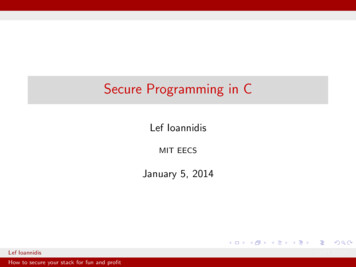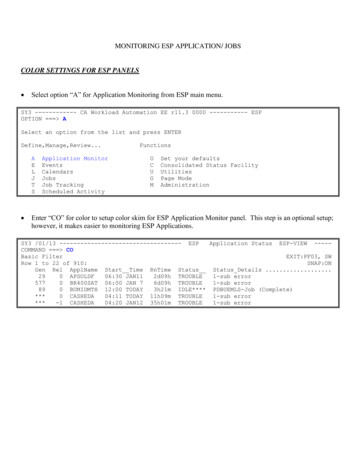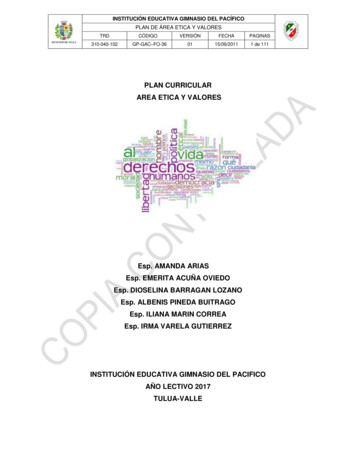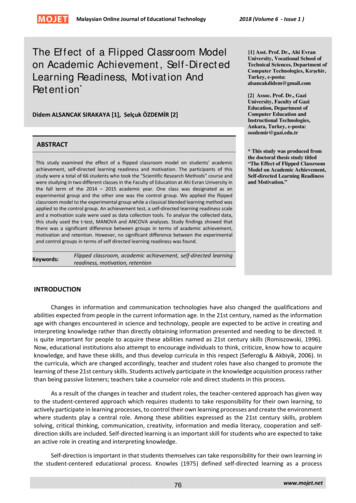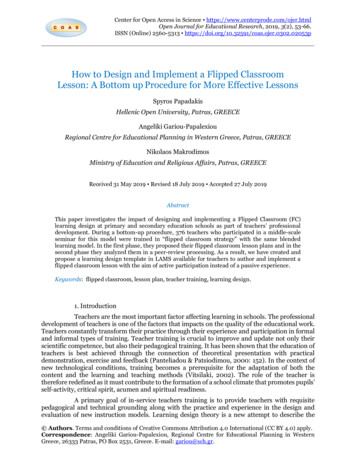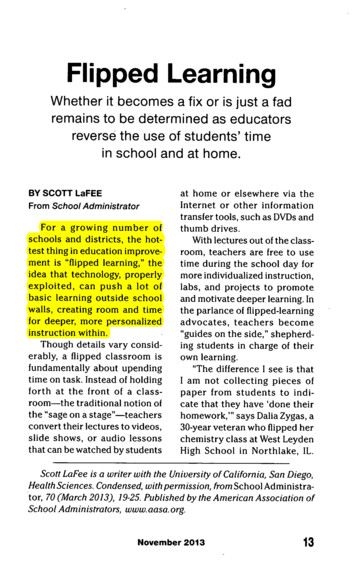
Transcription
Flipped LearningWhether it becomes a fix or is just a fadremains to be determined as educatorsreverse the use of students' timein school and at home.BY SCOTT LaFEEFrom School AdministratorFor a growing number ofschools and districts, the hottest thing in education improvement is "flipped learning," theidea that technology, properlyexploited, can push a lot ofbasic learning outside schoolwalls, creating room and timefor deeper, more personalizedinstruction within.Though details vary considerably, a flipped classroom isfundamentally about upendingtime on task. Instead of holdingforth at the front of a classroom—the traditional notion ofthe "sage on a stage"—teachersconvert their lectures to videos,slide shows, or audio lessonsthat can be watched by studentsat home or elsewhere via theInternet or other informationtransfer tools, such as DVDs andthumb drives.With lectures out of the classroom, teachers are free to usetime during the school day formore individualized instruction,labs, and projects to promoteand motivate deeper learning. Inthe parlance of flipped-learningadvocates, teachers become"guides on the side," shepherding students in charge of theirown learning."The difference I see is thatI am not collecting pieces ofpaper from students to indicate that they have 'done theirhomework,'" says Dalia Zygas, a30-year veteran whoflippedherchemistry class at West LeydenHigh School in Northlake, IL.Scott LaFee is a writer with the University of California, San Diego,Health Sciences. Condensed, with permission, /rom School Administrator, 70 (March 2013), 19-25. Published by the American Association ofSchool Administrators, www.aasa.org.November 201313
THE EDUCATION DIGEST"Instead, students show methey know how to do something. They demonstrate theirunderstanding, for example, byindividually answering a question or two."Doubters AriseThe idea is not without skeptics, who question whether (1)the approach is practical orequitable in places where significant numbers of students(or schools) have insufficienttechnological resources; (2) itis truly applicable and scalablebeyond classrooms with highlymotivated and talented teachers and students; and (3) it really works better than currentinstructional models. Practicality and equity offlipped learning. The idea ofteachers converting lecturesand lessons to videos to bewatched as homework strikessome as problematic for variousreasons. Among them: How doyou do it if you've never doneit before? Where do you get thetraining, the technical tools,the time?Jonathan Bergmann and Aaron Sams are the faces of flippedlearning—or at least two of themovement's more high-profileproponents. In 2006, as highschool teachers in WoodlandPark, CO, they collaborated to14flip their chemistry classes.The effort was a huge success,so much so that Bergmann andSams have built new careerstouting the approach at conferences and workshops andthrough the Flipped LearningNetwork. Last year, they published a how-to manual calledFlip Your Classroom: Reach Every Student in Every Class EveryDay.Sams says technology andtime do not have to be major hurdles to flipping. He andBergmann flipped their firstclassroom with "two lousy computers" and 50 in software."There are a lot of free, simpleprograms to help people createvideos and other instructionalmaterials that don't require anything more than a smartphone,"he says. "You can partner witha colleague, something we encourage, and share the load."What about the other end—the students?"The flipped classroom isbased on the premise that students watch videos at home,which means we're not justbridging the digital divide atschool, we are doing it at home,"says Lisa Nielsen, a New Yorkbased teacher, administrator,and author of The InnovativeEducator blog."While I do believe we canwww.eddigest.com
Flipped Learningand must bridge the digital divide in school, this has not yettranslated to the home. Mostschools in high-poverty areasthat provide technology do notlet students bring the deviceshome," Nielsen says, "Additionally, the hardware is only onepart of the equation, Internetaccess is the other. We are stilla long way from providing theInternet to students whose families can't afford it,"Flipped-learning advocatescounter that it's not about having the latest smartphone oriPad, At relatively little expenseor trouble, teachers can burnlow-tech DVDs, send homematerials on thumb drives, orprovide extra time and accessto materials during the day forstudents who need it,"There are definitely waysof going about nipping withoutheavy technology use," saysAndy Schwen, a middle schoolmath teacher in the AnokaHennepin (MN) School District,"such as reading ahead of timeor doing investigation activitiesat home that launch activitiesfor class the next day,"So far, the flipped-learningmovement has been primarily agrassroots phenomenon implemented by individual teachers.Proponents say this is generallygood, that the idea cannot suc-ceed as a top-down mandate,"If administrators decidetheir district is going to beflipped and teachers are noton board, it will not be nearlyas effective as the other wayaround," says Steve Kelly, ahigh school math teacher in St,Louis, MI,Do administrators have arole?"Absolutely, they are criticalas instructional leaders andlead learners in their schools,"says Justin Reich, a fellow atTechnology and timedo not have to bemajor hurdlesto flipping.the Berkman Center for Internetand Society at Harvard University and cofounder of EdTechTeacher, which helps eductorsleverage new technologies tosupport student learning, "Theycan support innovation, providecollaborative time and professional development, assignresources to innovative teachers, communicate with parentsabout new teaching strategies,and provide feedback and a viewfrom outside the classroom,"Most important, adminis-November 201315
THE EDUCATION DIGESTtrators can provide supportfor new ideas and teachingstrategies, Reich adds. "I'vebeen struck over the years byhow many teachers tell me thatencouragement from principalsand superintendents really matters."Bergmann says the primaryreason administrators balk atflipped learning is a lack offamiliarity: "They need moreinformation about how it works,the issues that come up likehow to evaluate flipped-learningteachers, the problems of rolling it out." Applicability and scalabilityof flipped learning. Good teachers use technology well. On theother hand, good teachers alsoare adept at practices seen asless cutting edge or innovative.It is possible to make a lectureinteresting, engaging, and informative."It's easy to discuss the negatives of a lecture," says ChrisFaulkner, an instruction design consultant at the Centerfor Learning Enhancement, Assessment, and Redesign at theUniversity of North Texas inDentón. "There is a place for lecture, but it is far less prominentthan the credit educators havegiven it. One reason the flippedclassroom has taken off is thatit does not change the current16role of the teacher but still increases the potential benefitsfor students."That said, flipped learningwon't motivate every unmotivated student. It won't make abad teacher good."It's not the answer. It's away to answers," Bergmannacknowledges. "After we flippedour classrooms, Aaron and Iwere still unsatisfied. We knewwe could go deeper. Flippedlearning is a launching point todoing more. What that 'more'is depends on the teacher, thegrade level."Scalability is a real issue. Cana whole school curriculum beflipped? What about an entiredistrict? Does flipping workequally well with all subjects?Advocates say yes. They citeentities such as the Khan Academy, a nonprofit founded by IvyLeague-trained math whiz Salman Khan in 2006, which offersmore than 3,500 short videosthrough YouTube. And placeslike Clinton High School in Clinton Township, MI, where everyclassroom has been flipped."Principal [Greg] Green is theposter child for flipped schoolleaders," says Kari Arfstrom, executive director of the FlippedLearning Network. "His testscores over the past three yearsare amazing."www.eddigest.com
Flipped Learning Whether flipping reallyworks. Green, who has beenClinton High's principal for 11years,firstimplemented flippedlearning three years ago ona modest scale—one government class composed mostlyof students with a history ofchronic underachievement.The approach was fairly simple.Students would do basic content at night, watching videos or participating in onlinegroup discussions. Classroomtime would be more devotedto one-on-one instruction andprojects.One semester later, theflipped government class hadbetter grades than a traditionalcounterpart. Green expandedthe flipped model to 140 incoming high school freshmen.Again, he found success. Thefailure rate dropped by 33% inEnglish language arts, 31% inmath, 22% in science, and 19% insocial studies. Standardized testscores went up, as did attendance. Disciplinary problemsdeclined 66%."I think this is the way youshould structure schools ingeneral," Green says. "It makessense to practice what you learnin class, with a teacher besideyou to help, rather than at homewith somebody who might notbe an expert or may have otherresponsibilities or distractions."Still, Clinton's success is thestory of a single school. Thereare almost no broad-based empirical data yet about the efficacy of flipped learning. TheKhan collaboration is a work-inprogress. A few dozen schoolsnationwide are incorporating itsvideos in their online lessons,but it's too early to know howwell things are going.A small study conductedrecently by the research firmSRI International of students inOakland, CA, who used KhanAcademy materials found thatlagging math students caught upequally well whether they usedvideos or received tutoring insmall groups. A survey by theFlipped Learning Network of 453educators claims 67% reportedimproved student test scores.Bergmann, the Flip YourClassroom coauthor who nowworks as technology facilitatorat the Joseph Sears School inKenilworth, IL, concedes hardproof remains hard to come by,but he's confident findings ofongoing studies ultimately willback up anecdotal claims.An Elusive DefinitionMeanwhile, the movement isevolving and maturing in otherways. Right now, there appearsto be no consensus definition ofNovember 201317
THE EDUCATION DIGESTwhat exactlyflippedlearning is.Rather, it seems to be whateverits practitioner says it is, whichmay become problematic asthe number of adherents growsor calls grow for increased accountability and assessment."Sometimes the lack of acommon definition can causemisunderstandings and implementation problems," says Michael Gorman, who overseesa program at Woodside MiddleSchool, near Fort Wayne, IN,to integrate technology withcore curriculum standards. "Ateacher might attend a 45-minute conference session or webinar and believe they are readyto flip. Teachers need to studyand reflect on their definition oftheflip.They need to determinethe outcomes they desire andwhat might be some of the roadblocks as they implement."At its essence, Bergmannbelievesflippedlearning is builton four main pillars: Aflexible learning environ-ment. "I don't mean just kids notsitting in rows, staring at thefront of the class. It's teachersredesigning their class to makebest use of increased face-toface, individual instruction. It'sa lot more freedom to do thingslike project-based learning." A revamped learning culture in the classroom. "Students18take responsibility for theirown learning. I think every kidshould have an individualizededucation program. Not thepaperwork, but the personalization. We need to move away a bitfrom standardization." Intentional content. "Thismeans creating quality videosand other materials to supportlearning in the classroom. It'sbest if teachers produce them,but it's not necessary." Professional educators."Thus far, flipped learning hasbeen mostly a grassroots effort.It needs to professionalize. Weneed to identify and disseminatebest practices, share ideas, andget people connected."Bergmann does not describeflipped learning as pedagogicalreform. It's a tool, a new way ofdoing things. "It leverages oldideas in new ways," he says."It allows technology to makethings more inventive and reachdifferent students in differentways."Whether this is enough toensureflippedlearning enduresand prospers remains to beseen.Is it a fad? The history of education is fraught with them."I certainly hope not,"Bergmann replies. "I've seenit change too many people'slives." www.eddigest.com
Copyright of Education Digest is the property of Prakken Publications and its content may notbe copied or emailed to multiple sites or posted to a listserv without the copyright holder'sexpress written permission. However, users may print, download, or email articles forindividual use.
emy, a nonprofit founded by Ivy League-trained math whiz Sal-man Khan in 2006, which offers more than 3,500 short videos through YouTube. And places like Clinton High School in Clin-ton Township, MI, where every classroom has been flipped. "Principal [Greg] Green is the poster child for flipped school leaders," says Kari Arfstrom, ex-

